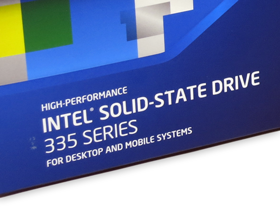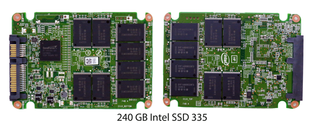Intel SSD 335 240 GB Review: Driving Down Prices With 20 nm NAND

Intel SSD 335 240 GB: Refreshing SSD 330 With 20 nm NAND
Update, November 29, 2012: Shortly after this story went live, Intel sent us an email stating: "Engineering has confirmed that the media wear indicator…is not reporting correctly on the SSD 335. The MWI calculation is an algorithm, which is based on P/E cycles of the NAND and the NAND writes. Intel found that the numbers used in the 335-series algorithm were not correct and decrementing twice as fast as they should." We just finished re-testing endurance, and you can see the results on page eight. The old speculative discussion about endurance is gone in order to avoid confusion. Intel’s warranty period is still three years on the retail SSD 330 and 335, so we continue to believe endurance should not be a concern on these drives, even if you’re thrashing them.
Back in September, Samsung launched its 840 Pro, and we declared it the fastest, most efficient SSD we had ever tested. The company used an updated controller, a tuned firmware, and the first Toggle-mode 2.0-compatible flash memory to achieve great performance all around. Check out Samsung 840 Pro SSD: More Speed, Less Power, And Toggle-Mode 2.0 for more about that drive. With such a compelling product in our labs, what more could anyone want from an SSD?
A lower price, to start with. Newegg currently has the 256 GB 840 Pro listed for pre-order at $270. That's more than a dollar per gigabyte of storage (an amazing deal by last year's standards, but not nearly as compelling as some of the deals we flagged in Best SSDs For The Money: October 2012, which dip under $.70/GB). Clearly, you have to pay to play when it comes to the quickest hardware available.
Intel's approach to the solid-state storage market is quite a bit different. Once the pioneer in controller technology, it now relies on third-party vendors for the logic that drives its highest-end client-oriented drives. Most recently, the company's SSD 330 saw Intel adopt 6 Gb/s controller logic from SandForce, mated to its own 25 nm multi-level cell NAND (Intel SSD 330 Review: 60, 120, And 180 GB Models Benchmarked).

And now it's evolving that SSD 330 with flash memory manufactured using an even smaller 20 nm process. Presumably in an effort to avoid the issues that OCZ encountered when it silently started using new NAND on its Vertex 2 drives, but failed to disclose (we explored all of that in The OCZ Vertex 2 Conspiracy: Lost Space, Lost Speed?), Intel is calling its new drive the SSD 335 and launching it in one trim: 240 GB. Performance specs don't change relative to the 240 GB SSD 330, but pricing does, and common sense tells us that endurance should as well.

In fact, for the first time, Intel is introducing an SSD at a price point under $1/GB. Yeah, we know that's not particularly stellar in a market hammered by competing brands pushing per-gigabyte costs 20 and 30% lower (particularly since many of them are using SandForce's technology, too). But remember that plenty of folks are willing to pay a premium for Intel's name. A compelling "better together" story is big business for the company, and it's common to see its CPUs, motherboards, network controllers, and SSDs all used in the same system.

The revelation that Intel keeps performance constant on the SSD 335 is an interesting one. We know the SSD 330 and 520 both employ 25 nm synchronous NAND and an ONFi 2.2 interface. They use the same SandForce controller, too. Thus, we can be relatively certain that the SSD 330's lower performance comes from its firmware (a hypothesis made more probable by our discovery that the SSD 330 employs the same PCB as the 520).
Stay on the Cutting Edge
Join the experts who read Tom's Hardware for the inside track on enthusiast PC tech news — and have for over 25 years. We'll send breaking news and in-depth reviews of CPUs, GPUs, AI, maker hardware and more straight to your inbox.
| 240 GB Performance Comparison (Assuming Compressible Data) | |||
|---|---|---|---|
| Row 0 - Cell 0 | Intel SSD 330 | Intel SSD 335 | Intel SSD 520 |
| 4 KB Random Read (IOPS) | 42 000 | 42 000 | 46 000 |
| 4 KB Random Write (IOPS) | 52 000 | 52 000 | 56 000 |
| 128 KB Sequential Read (MB/s) | 500 | 500 | 550 |
| 128 KB Sequential Write (MB/s) | 450 | 450 | 515 |
Because the SSD 335 wields those same specifications, it's consequently hard for us to know for sure whether the 20 nm NAND affects performance. More certain is that a new process node does have an impact on endurance, and we'll be looking to quantify that change in today's review.

Naturally, IMFT isn't getting specific about the differences between its 20 nm high-capacity NAND and last generation's 25 nm process. But the company claims to achieve similar performance and endurance. A fairly conservative company, Intel doesn't tend to adopt new technologies prematurely. And, given an identical three-year warranty on the SSD 335, we have every reason to believe end-users won't be affected by this subtle transition. We're going to run the numbers the best way we know how, anyway, though.
Current page: Intel SSD 335 240 GB: Refreshing SSD 330 With 20 nm NAND
Next Page Test Setup And Benchmarks-
mayankleoboy1 Read only the conclusion. Most of these SSD's are "me-too" clones using SF2281 controller. Most have similar performance wins and pitfalls.Reply
I was super excited about Samsung 840. But these are meh. -
christophermarti I would say that your estimates about P/E cycles are incorrect. You also do not mention (on purpose) two modes SSD's (99%) operate in: performance mode (not filled to 90%) and storage mode (filled 90% and more). You also lack to mention that in "middle of" P/E cycle exhaustion SSD's will slow down their speed due to preserve P/E cycles and "survive" to meet warranty agreements.Reply
http://www.xtremesystems.org/forums/showthread.php?271063-SSD-Write-Endurance-25nm-Vs-34nm/page211
From test exposed in this forum You can draw conclusion how good MLC used in X-25v 40GB SSD were (more than 35000 P/E). Also that longest "standing" SSD is Samsung 830 256GB, which also do not (as an exception) slow down considerably when it passes 1PB Host Writes mark.
Although I strongly do agree that seing writes above 10GB per day is rather rare. I'm myself using 80GB X25-M for 4 years and only 4,09 TB and i is possible that it will hold up to 1400 - 3400 TB of writes! That's amazing. What's more, I have it in Dell E6400 on Vista (no Trim, just Intel toolbox).
-
christophermarti http://www.xtremesystems.org/forums/showthread.php?271063-SSD-Write-Endurance-25nm-Vs-34nm&p=5148307&viewfull=1#post5148307 - 1000 P/E cycles (not even close to 35100 of 50nm old V40 GB).Reply -
alidan christophermartihttp://www.xtremesystems.org/forum ost5148307 - 1000 P/E cycles (not even close to 35100 of 50nm old V40 GB).Reply
keep in mind that is still 240000 gb of data at minimum -
abbadon_34 so if it's firmware crippled, can we just flash a the firmware and get a better drive? someone needs to do some testing....Reply -
acku christophermartiI would say that your estimates about P/E cycles are incorrect. You also do not mention (on purpose) two modes SSD's (99%) operate in: performance mode (not filled to 90%) and storage mode (filled 90% and more). You also lack to mention that in "middle of" P/E cycle exhaustion SSD's will slow down their speed due to preserve P/E cycles and "survive" to meet warranty agreements. http://www.xtremesystems.org/forum nm/page211From test exposed in this forum You can draw conclusion how good MLC used in X-25v 40GB SSD were (more than 35000 P/E). Also that longest "standing" SSD is Samsung 830 256GB, which also do not (as an exception) slow down considerably when it passes 1PB Host Writes mark.Although I strongly do agree that seing writes above 10GB per day is rather rare. I'm myself using 80GB X25-M for 4 years and only 4,09 TB and i is possible that it will hold up to 1400 - 3400 TB of writes! That's amazing. What's more, I have it in Dell E6400 on Vista (no Trim, just Intel toolbox).Reply
Our calculations and endurance protocol are not effected by any speed slow down, and in every test, we've confirmed our methodology applies a WA~1%. Thus, are estimates are correct and apply to the NAND itself.
Second, the speed of a drive has no inherent bearing on endurance. It only affects how fast you can get there. Second, you're referring to a throttling effect, which is a different topic completely. Our analysis was specific to the NAND itself.
As further verification, another one of my peers (at another site) independently came to results for the SSD 335 similar to ours. -
cumi2k4 how come vertex 4 did not get tested? didn't ocz offer 5 years for their vertex 4, and i believe they're offering them at cut-throat pricing?Reply -
mayankleoboy1 One thing i notice is that with an Antivirus program(Kaspersky Internet security) running in the background, which 95% of Toms readers would have, the AV program reads and writes data almost continuously. In a typical day, the AV program can write 5-6GB of data.Reply -
jabliese Power consumption made me laugh. 1 watt difference between the best and worst. Time for another 1 line standard SSD review comment, "Power usage on SSD's matters little between the best and worst."Reply
And please keep reiterating the most important thing about an SSD is getting one. Ran into SSD resistance on another forum just a couple weeks back, which, at today's price points, blew me away. -
acku cumi2k4how come vertex 4 did not get tested? didn't ocz offer 5 years for their vertex 4, and i believe they're offering them at cut-throat pricing?Reply
Look again. It is included in our benchmarks.
